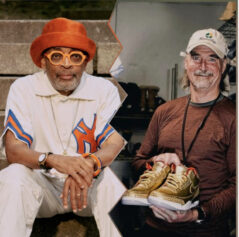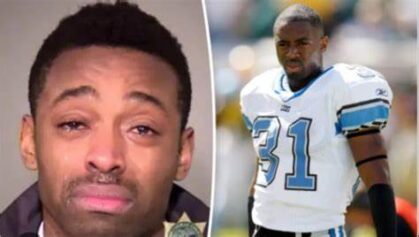The death of Eric Garner at the hands of a New York City police officer is the latest in the ongoing drama between law enforcement officials and the African American community. A cell phone video of Garner being accosted, subdued, and eventually killed by the NYPD has proliferated across the Internet and reignited long-simmering tensions regarding officers who use unnecessary and excessive force. Director Spike Lee related the tragic incident to his classic 1989 film Do the Right Thing, when his character, Radio Raheem (Bill Nunn), became the victim of a chokehold. Like Garner, Raheem was a large black man who police felt needed maximum physical force to subdue. Lee spliced the real life video of Garner being choked with a scene from Do the Right Thing.
Police say Garner had been arrested multiple times for selling untaxed cigarettes in the past. Suspecting him of the same crime, the now infamous video illustrates Garner attempting to explain to officers that he’d done nothing wrong. Eyewitness Ramsey Orta told Time magazine that Garner had just broken up a fight between two individuals. Ignoring Garners attempts at reasoning, an officer approached him from behind and applied a chokehold and pulled him down to the ground. Garner repeatedly said he could not being able to breathe, but those pleas fell on deaf ears as the chokehold ultimately contributed to his death by cardiac arrest.
Though autopsy results haven’t been revealed yet, authorities say he died from a heart attack while in police custody. And now, questions abound regarding the chokehold method and whether or not it was necessary. Hoping to make quick amends, on Tuesday, NY police commissioner William Bratton told reporters that he has ordered a review of the NYPD’s training procedures in light of this recent circumstance. He says they’ll make a "top to bottom review of all of the training this department provides to its personnel, specifically focusing on force, how do we train our officers for a takedown, how do we train them to use the various levels of force that they're authorized to use."
Stating that the entire 35,000-member NYPD will be retrained in the wake of Garner's death, the department will also research and review how officers are currently being trained. A team is also being sent to study the Los Angeles Police Department, who amended their tactics for subduing suspects after a rash of chokehold related lawsuits were levied against them in the 1990s.
But this is absolutely not enough. Although the NYPD has removed the gun and badge of eight year NYPD veteran, Daniel Pantaleo, he remains unfired, not charged, and on “modified assignment” desk duty pending investigative outcomes from the district attorney and Internal Affairs. “You don’t need no training to stop choking a man who says I can’t breathe,” declared Rev. Al Sharpton at Garner’s Wednesday funeral at Bethel Baptist Church in Brooklyn, NY. “You need to be prosecuted.”
This wasn't Pantaleo's first on-the-job drama. The Staten Island Advance reported that he'd been sued for civil rights violations twice in the past. In the first case, the officer and his partner were accused of strip-searching two men in broad daylight during a traffic stop. The suspects were then strip-searched, again, at the 120th precinct station. That case resulted in dropped drug charges for one of the defendants and a $30,000 settlement.
Four EMT workers affiliated with Richmond University Medical Center have been suspended without pay for failure to administer proper aid to Garner after he passed out. The use of the chokehold has been a sticking point and seemingly like the status quo for officers accused of brutality. Numbers support these claims. According to the New York Times, the Citizen Complaint Review Board received 1,022 chokehold claims from 2009 to 2013. Only nine of those incidents resulted in some form of investigation. Former NYPD chief Ray Kelly refused to administer discipline against officers in eight of these cases.
On Tuesday, a candlelight vigil was held in Staten Island, NY by a group of family, friends and community organizers demanded justice for the death of Garner. Wednesday's funeral in Brooklyn attracted hundreds of family, friends and supporters.
Still, supporters of the NYPD blame Garner, saying he brought death upon himself by resisting arrest. Posts to pro law enforcement sites like Thee Rant and PoliceOne.com, which afford courage to individuals who would likely never say such things in a forum where their identities are revealed, reveal a very callous attitude toward the situation.
"Mayor you killed our effectiveness on the street, when you killed Stop and Frisk. Because of a few bleeding heart liberals and a few ethnic groups who believe they are the only ones being stopped. You shut down the whole system. Because now all those baggy … pants you see walking around are probably locked and loaded," said a poster on PoliceOne.com.
"If you can talk you can breathe! A strong and deadly choke hold would not allow a person to talk," said another.
Some within the African American community push for a radical stance to be taken against police brutality in the community, while most are proponents of a less hardline stance of nonviolent protest. The wide spread implementation of either method will likely do nothing to assuage fears of brutality in the inner city anytime soon. For many African Americans, it's all about respect. Something the NYPD and other police departments nationwide appear to have very little of for Black and Brown men, women, and people of color in general. Though increased dialogue between the community and the police has always been touted as the way to go, a one-sided conversation where comments and concerns are listened to, but not really heard, is an ongoing waste of time. Sadly, another incident like this will likely happen again and blow the lid off New York or any city nationwide where people of color come in numbers.



